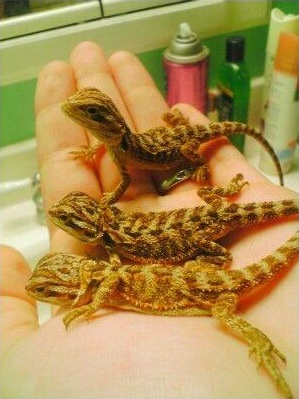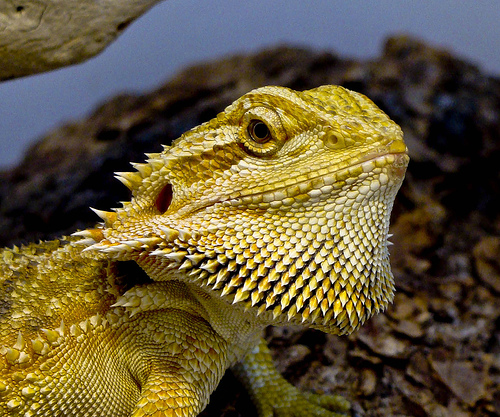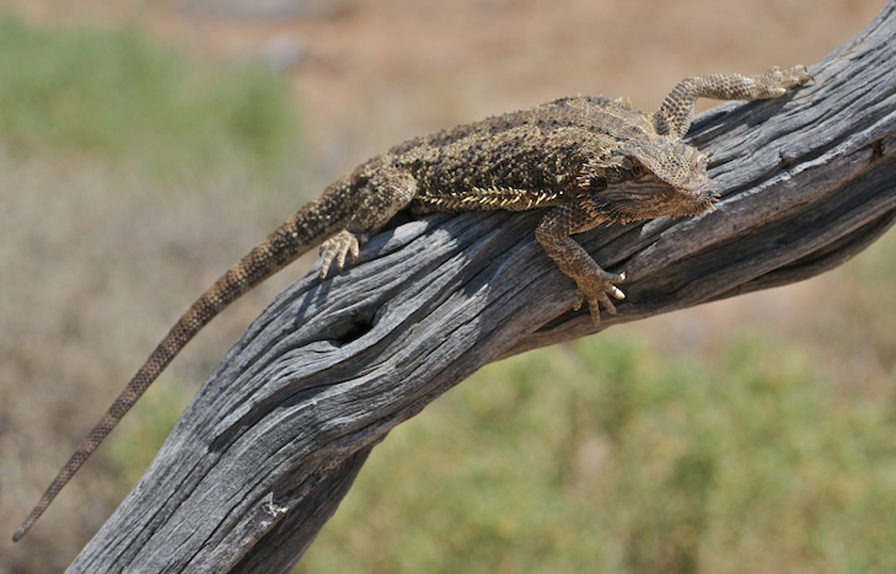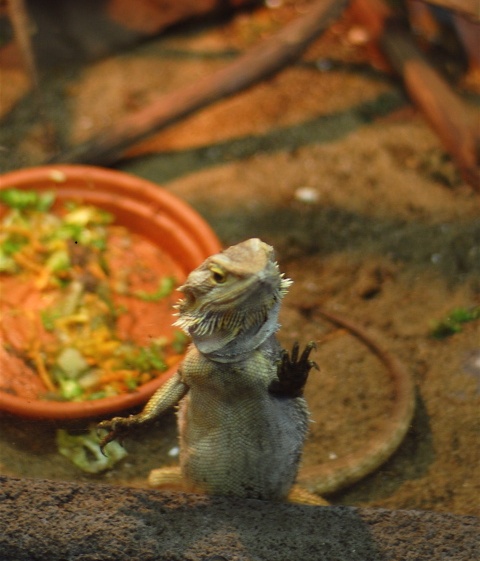Bearded Dragon: Australia's Goodwill Ambassador
/Bearded Dragon by Peter Weis
The Bearded Dragon (Pogona vitticeps) has become one of the most popular pet lizards, and it's easy to see why. It is a very tame lizard, and can be extremely personable. Bearded dragons also have a complex set of social behaviors - head bobbing, arm waving, posturing and extending their beards - that make them very interesting lizards to keep. The ready availability of captive-bred bearded dragons has made them a staple for the pet trade, and selective breeding creates an ever-increasing number of interesting color morphs.
Bearded Dragon: Caging and Lighting Requirements
Keeping bearded dragons successfully is directly dependent on the environment you provide. Because they are basking lizards from dry, hot areas in Australia, their terrarium needs to approximate that environment.
 Young hatchlings can be housed in a 10-gallon aquarium fitted with a screen cover and a 30 to 50-watt spotlight suspended over a basking area at one end of the cage. Under the spotlight, the young dragons should be able to reach a body temperature of 100 degrees Fahrenheit after basking for an hour. This temperature is necessary for them for proper food digestion. Arrange rocks and branches to provide several basking levels, then watch the hatchlings to ensure the lizards like to use the basking areas. Also, one end of the cage should be kept cool so the baby dragons can regulate their body temperature (thermoregulation).
Young hatchlings can be housed in a 10-gallon aquarium fitted with a screen cover and a 30 to 50-watt spotlight suspended over a basking area at one end of the cage. Under the spotlight, the young dragons should be able to reach a body temperature of 100 degrees Fahrenheit after basking for an hour. This temperature is necessary for them for proper food digestion. Arrange rocks and branches to provide several basking levels, then watch the hatchlings to ensure the lizards like to use the basking areas. Also, one end of the cage should be kept cool so the baby dragons can regulate their body temperature (thermoregulation).
Basking under a light is a more natural way for bearded dragons to receive heat, but some people use hot rocks or heating pads with their lizards. Use only the highest quality products and check them to make sure they have no hot spots that could burn small bearded dragons.
Suspend full-spectrum fluorescent lamps that emit both ultraviolet A and B wavelengths in the 5 to 10 percent range over the cage (look for them in your local pet stores; several are marketed specifically for reptiles). Arrange perches so the lizards can bask within 12 inches of the bulb and absorb the UVA and UVB light. This enables the lizards to manufacture vitamin D3, which assists in bone formation.
Washed children's play sand, aquarium sand or newspaper all are accepted substrates. Bearded dragons will readily eat substrate, so avoid any gravel or loose strands of carpet; they can cause blockage if ingested. Bearded dragons will attempt to eat anything you put in the cage, such as twigs, artificial plants and ornaments, so evaluate the safety of all cage furnishings.
It is important that the placement of cage fixtures allows the bearded dragons to get around the cage. Provide a very shallow, wide feeding dish for hatchlings so they can easily see their food. The lid of a deli cup works well. Arrange perches around the feeding dish to attract the baby dragons to the feeding area. You can use shallow plastic food-storage containers for larger animals. Select feeding containers just tall enough to contain the insects you feed to your bearded dragons, and it will be easy for them to get their food.
Bearded Dragon: Water and Food
Spray young hatchlings with water daily. Spray the cage sides, furnishings and the dragon's heads. They often lap up water as it is sprayed on them. Keep a fine mist of water directed on their heads as long as they keep lapping up the water. This stimulates the natural way bearded dragons get water in the wild, where they lick dewdrops from plant leaves. They also obtain water from daily spraying or from fresh vegetables in their diet. Don't expect bearded dragons to drink from a water dish.
 Young hatchlings should be fed insects such as small crickets, mealworms, beetle, larvae, baby upperworms and wax worms. Feed them every day to encourage optimal growth. Select feeder insects that are about the size of the lizard's heads so the hatchlings can easily devour them.
Young hatchlings should be fed insects such as small crickets, mealworms, beetle, larvae, baby upperworms and wax worms. Feed them every day to encourage optimal growth. Select feeder insects that are about the size of the lizard's heads so the hatchlings can easily devour them.
Vegetation is an important diet part of a bearded dragon. Thin leaves of red-tip lettuce, kale and other greens can be finely shredded and fed to the hatchlings, or pieces of leaf can be propped up so the lizards can easily take bites out of them. Potted plants, such as pursulane, pothos, hibiscus and garden greens,can also be placed in the cage and the lizards will benefit from the water content of the fresh leaves.
Pelleted diets formulated especially for bearded dragon can be available for both juveniles and adults. These diets can be used as part of a varied diet and are especially useful during times when live insects are not available. Moisten these foods with water of fruit juice before serving them to your pets. Place the food near basking sites or other open areas where the dragons can easily see it. It sometimes helps to move the pellets around in front of them with a wire or slender stick, so they learn to recognize the pellets as food. Some lizards won't eat commercial diets, so monitor your animals.
As hatchlings grow, move the larger ones to a different cage, or they will bully (or even attempt to eat) their smaller siblings. As they grow, offer larger food items and more vegetable matter. Large superworms (Zoophobas) can be a staple part of an adult dragon's diet, along with adult crickets, mealworms and fuzzy mice (baby mice that are just sprouting hair). Greens are very for them, including a cooked or raw chopped vegetable mix of green beans, carrots, corn, peas and broccoli.
Each dragon will have its favorite foods. They love to devour edible potted plants placed in their cages. Purslane and hibiscus are very good for them, and these plants can tolerate the high temperatures of a bearded dragon habitat. The sprouts of beans and sunflowers are very good for them, too (these items are often their favorite foods), and with a little planning, you should be able to provide a continuous supply.
Under optimum conditions, bearded dragons grow fast and can reach adult size within 12 months.
Bearded Dragon: The Importance of Supplementation
Most bearded dragons require calcium and vitamin/mineral supplementation if they grow well under captive conditions. Powdered calcium supplements containing vitamin D3 should be lightly sprinkled on their food every other day to promote healthy bone growth. If a dragon's lips start to separate or it has difficulty chewing its food, or its hind legs spasm or are held out stiffy, you need to supply more calcium and D3 in the animal's diet. Be aware that some individuals may require more supplementation than others. Liquid vitamin D3 products especially formulated for lizards can be used in combination with calcium supplementation to enhance the recovery of animals with severe calcium deficiencies.
 Full-spectrum lighting cannot duplicate the intensity of the ultraviolet radiation bearded dragons receive from direct sunlight, so bearded dragons kept indoors need additional calcium and D3 in their diets. Exercise caution when using multi-vitamin supplements, as bearded dragons are very susceptible to vitamin A toxicity, characterized by throat swelling, body bloating and lethargy.
Full-spectrum lighting cannot duplicate the intensity of the ultraviolet radiation bearded dragons receive from direct sunlight, so bearded dragons kept indoors need additional calcium and D3 in their diets. Exercise caution when using multi-vitamin supplements, as bearded dragons are very susceptible to vitamin A toxicity, characterized by throat swelling, body bloating and lethargy.
Specialty vitamin supplements contain beta carotene, which bearded dragons convert to vitamin A as they require it. Bearded dragons obtain most of the vitamins they need from their varied diet, so vitamin supplementation should be kept to a minimum. On the other hand, calcium supplementation is usually necessary for good bone growth. We (at Weis reptiles) have found that a mixture of four parts calcium to one part multivitamin supplement sprinkled on their food three times a week works well.
Sexing The Bearded Dragon
Juvenile bearded dragons become more sexually dimorphic every month as they grow. When they are 5 to 6 months old and 11 to 12 inches long, you can accurately sex bearded dragons by looking for hemipenile bulges on the males. To see them, gently arch the tail over the animal's back and gently twist and move it from side to side. The hemipenes can then be seen as firm lumps on either side of the underside of the tail base. Comparing several animals of known sex is a good is a good way to see the differences between the sexes. Experienced herpers can manually evert the hemipenes; have an expert show you how.
Secondary sexual characteristics include the males' wider, larger heads; larger femoral pores; and head bobbing, beard blackening and other obvious courting behavior.
Females have smaller heads, wider abdomens and a slower bowing head movement they make in response to the males' agitated head bobbing. Stereotyped arm waving is performed by both sexes when excited, especially if a dragon is confronted by a more dominant animal.
Bearded Dragon: Dominance
 Bearded dragons engage in a variety of interactions when forming a group hierarchy. Aggressive head bobbing displays and the appeasement displays of bowing and arm waving are a normal part of the social interaction in a group. Even small juveniles will start establishing a hierarchy. Dominant males tend to take the highest perch, so provide separate basking sites for sub-dominant animals.
Bearded dragons engage in a variety of interactions when forming a group hierarchy. Aggressive head bobbing displays and the appeasement displays of bowing and arm waving are a normal part of the social interaction in a group. Even small juveniles will start establishing a hierarchy. Dominant males tend to take the highest perch, so provide separate basking sites for sub-dominant animals.
Females establish hierarchies of their own, with dominant females "bulldozing" lesser animals off choice basking sites. It is normal behavior for males to chase females around the cage and nip them on their heads and necks in attempts to mount them. Both sexes may challenge each other with head-to-tail aggressive encounters that may result in bitten tail or toes. Larger lizards may stress out smaller ones just by their presence. Be alert for individuals that become intimidated or fight aggressively, or do not feed or bask as often as the others. Re-arrange cage furnishings, or move intimidated animals to a different cage to permit regular access to food, water and basking sites.
Bearded Dragon: The Dormancy Period
The onset of the bearded dragon dormant period can be quite bewildering for their owners if it is not expected, but it is a natural part of their life cycle. When bearded dragons become finicky eaters, hide a lot, dig in underground and, in general, become more subdued, they may be ready to start their dormancy period. Health problems may also cause this behaviour, so have a vet check the animals if you think a health problem may be involved. If animals have a good body weight and firm stools, yet suddenly become finicky eaters or dig and hide, it is probably a dormant behavior. Any bearded dragon can become dormant when triggered by its environment.
Late summer to early winter is a typical dormancy period. Reduced day length, cooler temperature and barometric changes are the usual triggers. Stress, such as a change in location or lighting, intimidation by other animals or inadequate nutrition can also trigger it.
During the dormant period, cage lights and heating pads can be turned off. Don't offer your dragons food at this time. They will only occasionally, if ever, drink water during the dormant period. The cage temperature can be lowered to 60 to 70 degrees. Provide hiding areas.
Monitor your animals every week or so. They should be awake, but subdued and groggy, and should feel cool and have reduced movement. Their eyes should be clear and free of mucous. My dragons' dormant period lasts four to eight weeks, but not longer than three months. If animals start losing excessive body weight, they should be taken out of dormancy to undergo an appropriate treatment program. Healthy animals should lose five to 15 percent of their body weight during this time.
Bearded dragons may pull out of dormancy on their own. Be alert for animals that resume activity. If they stay active for longer than two days, they have ended their dormant period. Otherwise, at the end of the dormant period, turn on the lights, raise the temperature and get the dragons eating and drinking again. Soak them in warm shallow water the first week and watch to see that they have resumed drinking. It may take one to two weeks for your dragons to resume normal levels of activity. Be alert for head bobbing and increased activity that signals the start of the breeding season two to six weeks after the dragons emerge from dormancy.
Bearded Dragon: Potential Diseases
Bearded dragons are very hardy, but they can still get sick. The five most common problems are calcium imbalance, pinworms, pathogenic protozoans, respiratory disorders and coccidia. It is important to recognize the early stages of these problems so corrective action can be taken in a timely manner. See a qualified reptile veterinarian for advice and treatment.
Calcium deficiencies have a number of symptoms. As mentioned, if your dragons' lips start separate, they have difficulty chewing their food, their hind legs go into spasm or are help out stiffy, or if the backbone has a ridged appearance, you need to supply more calcium and D3. Be aware that dragons may require more supplementation than others.
Pinworms, protozoans and coccidia can be transmitted by live prey times, or through cross contamination from other animals. Stress can cause these organisms to proliferate and cause a problem. Be alert for any changes in the appearance of your lizards' stools (runny, smelly, slimy). A veterinarian can examine a fresh fecal sample to detect the problem organism and initiate appropriate treatment.
Respiratory problems are indicated by open-mouth breathing, clogged nostrils, excessive mucous in the mouth and general apathy. Most respiratory ailments are caused by too-cool or moist conditions combined with suboptimal basking areas, or chronic stress. They can be hard to treat and usually require antibiotics.
Bearded Dragon: Color Morphs
We have bred bearded dragons for a number of generations and have found many variations both individually and along genetic lines. An understanding of the genetic inheritance patterns of bearded dragons is beginning to emerge as more selective breeding is done to enhance the coloration and other characteristics of this variable species.
In a shipment of bearded dragons we received from overseas, there were some un-usually large and colorful adults. Some of their offspring were more colorful than the parents, and were more colorful than the parents, and were very hardy with a fast growth rate. The grown females proved to be prolific breeders. These superior characteristics formed the basis of our "Red Flame" lineage. These lizards tend to have orange or yellow heads with a gold over-cast to their tan bodies. They are large and active. We are currently breeding these dragons with other red-phase dragons to add their vitality to other lineage.
We also received some bearded dragons from Germany, which grew to unusually large sizes, in excess of 2 feet. Adult males were particularly impressive because they had the larget heads of any of our bearded dragons. The females had unusually large clutches, too, often with more than 30 eggs per clutch. These combinations of characters formed the basis of our "German Giant" dragons. As we investigates the origin of these animals, we found that they were the descendants of a wild-caught female and one of the first bearded dragons that had ever been bred in captivity. Their superior disease resistance is probably the result of the many generations they have been captive bred, resulting in a partial resistance to the particular afflictions of lizards in captivity. The German Giants have proven to be very hardy and prolific.
 The first color phase we developed occurred entirely by accident. We received reports from customers that some of the baby bearded dragons we had sent them were developing an orange coloration. We were able to trace the offspring back to an ordinary light tan female. We held back some of her subsequent offspring, and some developed the orange coloration. These animals formed the basis of our Orange Phase dragons. They are bred to have vivid orange eyelids with yellow highlights on the face, an orange beard and light buff-brown bodies. As youngsters, they tend to have orange spots down the back. They are very tame, too.
The first color phase we developed occurred entirely by accident. We received reports from customers that some of the baby bearded dragons we had sent them were developing an orange coloration. We were able to trace the offspring back to an ordinary light tan female. We held back some of her subsequent offspring, and some developed the orange coloration. These animals formed the basis of our Orange Phase dragons. They are bred to have vivid orange eyelids with yellow highlights on the face, an orange beard and light buff-brown bodies. As youngsters, they tend to have orange spots down the back. They are very tame, too.
We eventually bred these dragons to the much darker Giant German dragons. The subsequent offspring were selectively bred to develop two new morphs: the Orange X Giant German and the Orange Tiger pattern. The Orange X Giant German has the tameness and color from the Orange phase combined with the size, disease resistance and productivity of the Giant German. They are very popular and tend to have touches of orange on the head and light spots down the back.
The Orange Tigers were developed by crossing Orange Phase dragons with dark phase Giant Germans, which resulted in the dark brown tiger sidebars on these lizards. They retain the orange coloration on the head and down the back and are vividly patterned, which makes them popular.
First produced in 1998, the Orange glow dragon is a combination of Red Flame X Sandfire back-crossed to Orange Phase dragons. These lizards have the most intense coloration. Some are darker with orange and red coloration; some are a lighter yellow and orange. Their large size, productivity and disease resistance are inherited from the German Giant present in the Red Flame animals; the intense color comes from the Sandfires; and their tameness and color are reminiscent of the Orange Phase.
Leucistic dragons derive from a genetic mutation for color in a single bearded dragon. The Europeans were the first to develop a leucistic dragon, as advertised by T-Rex as the snow dragon (not to be confused with the American line of snow dragons, which are unrelated). Pure leucistics are the whitest of all bearded dragons, and patternless. Some retain orange or yellow highlights on the head. Because the mutation involves the absence of dark pigments, leucistic bearded dragons tend to have pale shoulder epaulets and clear nails, which distinguish them from other light-colored bearded dragons. They also seem to have the lowest disease resistance of all bearded dragons, due to their inbred nature.
Bearded Dragon: In Closing
Because large numbers of bearded dragons are now being bred, their husbandry requirements are the best understood of any agamid lizard. There are variety of specialty products available for their care. Bearded dragon hardiness and variability has enabled selective breeding programs to develop new color morphs on almost a yearly basis. Their productivity has enables to fulfill the demands of the pet trade. Bearded dragon vary in color and pattern, size and temperament and their many interesting behaviors do, indeed, rank bearded dragons among the most popular of pet lizards.





